
4066R
Compact Utility Tractor
- 49 kW (65 hp) Yanmar® 2 L diesel engine
- Transmission Two-Pedal Automatic
- Standard 4-wheel-drive
- Category 1, 3-point hitch
- Choice of Open Station or ComfortGard™ Cab
Features
Attractive styling provides improved visibility and serviceability
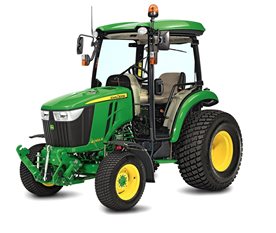 4066R Tractor
4066R Tractor 
The bold styling of the 4R Tractors provides an attractive and functional appearance similar to that of the larger agricultural tractors. Benefits of this styling include:
- Easy tractor family identification
- Updated fixed grille and side panel hood design allows for optimum sealing of the cooling compartment
- Front grille slides up to an integrated maintenance position for easy battery access
- Easily removable cowl, allowing for serviceability access
- Wraparound-style light-emitting diode (LED) headlights
- Premium integrated automotive style headlight bezels
- Bold graphics
- Aggressively sloped hood design, giving a softer, smoother look and providing improved visibility
- Hybrid (4066M and 4066R) exhaust in base for cab tractors allows for clear operator visibility and safety
- At low speed and when tractor is in a filter cleaning process, the exhaust will be routed through vertical exhaust outlet. In all other cases, the exhaust will be routed through the downward exhaust outlet.
- This ensures minimal heat impact to operator
The result gives the tractor a distinctive appearance and feel.
NOTE: If the tractor is equipped with an optional field-installed vertical exhaust, the exhaust pipe must be removed before opening and closing the hood of the tractor.
Operator station is comfortable and convenient
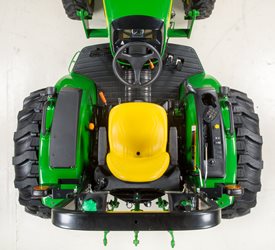 Easy entry and exit from the operator's station
Easy entry and exit from the operator's station 
The operator's station is designed for easy entry and exit from the tractor.
Conveniently placed brake pedals, as well as repositioned operator controls, provide for a clean and flat platform design, giving the operator plenty of legroom.
- Hood and fenders are made from composite polymer material designed to eliminate the possibility of rusting and resistant to dents that can occur with metal hoods and fenders. This material provides a high-luster appearance with excellent resilience and resistance to fading from sunlight.
- Easy-fold rollover protective structure (ROPS), with built-in, rattle-reducing, tension rod.
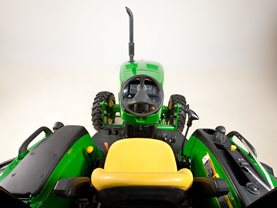 Comfortable and convenient design
Comfortable and convenient design 
Key features of the operator's station include:
- Large grab handles on each fender to make getting on and off the tractor easy
- Foot platform that is rubber mounted and incorporates a rubber mat for operator comfort
- Center console and fender toolboxes that provide ample storage
- Large cup holder on right-hand fender
- Fender-mounted forward work lights (two lights)
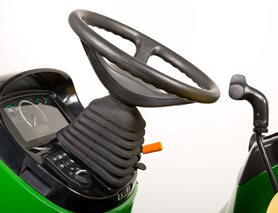 Adjustable, tilt steering wheel
Adjustable, tilt steering wheel 
- Improved tilt steering wheel design is in base equipment. The tilt wheel:
- Allows the operator to adjust the steering wheel to the most comfortable position
- Provides additional clearance for the operator to enter and exit the tractor
- Provides easy return to fully raised position
- Provides plenty of room for comfortable operation
- Controls are shape and color-coded for easier identification and operation
- 12-V outlet is standard on the 4R Tractors and provides power for mobile devices
- Integrated junction block provides switched and unswitched power to add additional accessories
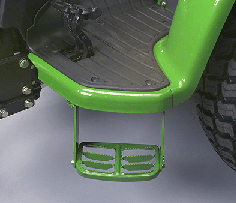 Left-side step
Left-side step 
- A left-side step is in base equipment to enhance access to the operator's station
 Adjustable scissor-type suspension seat
Adjustable scissor-type suspension seat 
- Swivel seat adjustment (1) with armrests is in base equipment on all 4R open station tractors to decrease operator fatigue when operating rear-driven implements. The seat swivels 15 degrees in either direction. It also provides convenience and comfort while entering and exiting the tractor.
- An air suspension seat is optional for the 4R Series Tractors.
- Air suspension is not compatible with the swivel function.
- An air suspension seat is optional for the 4R Series Tractors.
- The scissor-type suspension seat gives the operator a comfortable ride. The seat flips forward for protection from the elements.
- Seat suspension is adjustable for the operator's weight and height.
- Operator weight adjustment (2) adjusts to the operator’s weight (52.2 kg to 124.7 kg [115 lb to 275 lb]).
- The seat is adjustable fore and aft for the operator’s height using the lever (3) located under the seat.
- Retractable seat belts prevent belts from becoming tangled in seat suspension and controls.
Powerful Yanmar® diesel engine delivers plenty of power under heavy loads
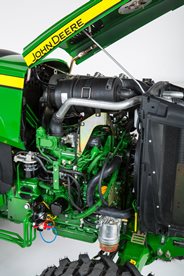 Powerful Yanmar engine
Powerful Yanmar engine The Yanmar diesel engine has a high-torque reserve that provides plenty of power under heavy load.
This 4-cylinder engine features lower levels of exhaust emissions and reduced noise levels. It meets EPA Final Tier 4 (FT4) emission standards.
Model | Number of cylinders | Engine displacement | Aspiration | Rated rpm | Gross engine kW* | Gross engine hp* | PTO hp |
4044/R | 4 | 2.1 L | Natural | 2600 | 37.1 | 42.5 | 32.3 |
4066M/R | 4 | 2.1 L | Turbocharged | 2600 | 48.5 | 65 | 51.9 |
*Engine hp (kW), gross SAE J1995: 43.1 (31.7) at 2600 rpm, PS Displacement, cu in. (L):134.25 (2.2)
*Engine hp (kW), gross SAE J1995: 65.9 (48.5) at 2600 rpm, PS Displacement, cu in. (L):128.15 (2.1)
The engine uses the latest technologies to optimize fuel economy, improve control and accuracy, and reduce environmental impact.
The common rail system (CRS) optimizes fuel economy and reduces operating costs (compared to engines not using CRS technology). High-pressure injection atomizes fuel into finer particles which burn more completely. It results in improved fuel economy and lower cost of operation.
The electronic control unit (ECU) provides optimum fuel control and accuracy. ECU monitors and controls the engine. It continuously monitors engine conditions and adjusts the fuel delivery accordingly to ensure optimum performance and emissions.
The engine comes with an aftertreatment system. The system operates automatically. The exhaust filter consists of a diesel particulate filter (DPF) which captures particulate matter (PM) contained in the exhaust gas. Using a natural cleaning process, most of the PM trapped in the exhaust filter is eliminated by the heat of the exhaust stream generated by normal use. In situations of low temperature, engine speed or load factor, an active cleaning cycle is initiated. In this cleaning cycle, the exhaust gas temperature is raised by injecting additional fuel during the exhaust stroke of normal vehicle operation to the diesel oxidation catalyst (DOC).
After many hours of use, the exhaust filter may require an ash removal service.
DPF cleaning
Depending on the load that the tractor is under, as well as ambient temperature, humidity, and engine speed, the DPF may build up with particulate matter, thus requiring cleaning. Filter cleaning is determined by one of three conditions:
- A prescribed time-based estimation of needed filter cleaning
- DOC/DPF pressure sensors
- A particulate matter buildup estimation based on load conditions
Once one of the three conditions has been met, filter cleaning will occur.
There are three different types of filter cleaning processes:
- Passive filter cleaning
- Active filter cleaning
- Parked filter cleaning
Passive filter cleaning
Passive filter cleaning occurs naturally when the engine is generating enough heat to oxidize particulate matter. This automatic process occurs continuously during normal operating conditions. No tractor icons or symbols appear on the display during passive filter cleaning.
NOTE: Passive filter cleaning requires no operator involvement, and there is no interruption to tractor operation.
Active filter cleaning
If conditions (temperature, load, or speed) for passive filter cleaning cannot be achieved, then PM is removed using active filter cleaner.
To achieve the required conditions, exhaust temperature management (ETM) manages the initiation and duration of active filter cleaning. ETM can adjust numerous engine parameters and/or inject a small quantity of fuel into the exhaust stream for a short duration. The fuel turns to vapor and chemically reacts with the catalysts in the DOC to create heat to oxidize PM.
It is important to note that at no time is the fuel in the DOC/DPF ignited, and there is no flame within the DOC/DPF.
Like passive filter cleaning, active filter cleaning requires no operator involvement, and there is no interruption to tractor operation.
Parked filter cleaning
In some instances where passive and active filter cleaning have not fully cleaned the PM from the system, a parked filter cleaning may need to take place. Most likely, the only time a parked filter cleaning will need to occur is when automatic filter cleaning has been disabled for an extended period of time and multiple warnings to engage filter cleaning were ignored or if the tractor has been used during light load conditions. Additionally, when the automatic filter cleaning process has been deliberately interrupted multiple times, or if active filter cleaning has failed numerous times due to a failed component, a parked filter cleaning may be requested. In these rare instances the operator will have to park the tractor and start the filter cleaning process.
The parked filter cleaning process needs to be activated based on usage and operation of the tractor. The process will take approximately 30 minutes. See operator’s manual for more details.
This system constantly monitors the soot level of the tractor, making sure the tractor is always in peak performance condition. This ensures high performance at all times.
NOTE: Number of hours since last regeneration and soot level percentage viewable on LCD display.
Key features of the engine are:
- Lower rated speed for 540 rpm power take-off (PTO) operation means better fuel economy, less noise and vibration, and longer overall engine life
- Cast-in-block cylinder design for good cooling and long life
- Hydraulic lifters are quieter and require no adjustment
- Heavy-duty crankshaft provides more bearing surface area for added durability
- CRS optimizes fuel economy, lowering the cost of operation
- ECU provides optimum control and accuracy
- Direct fuel injection
- Improves starting
- Injects fuel directly on top of pistons for more efficient combustion
- Develops more horsepower per gallon of fuel
- Glow plugs (cold starting aid)
- Engine oil cooler, cools engine oil for longer engine life
- Key start and shutoff eliminates fuel shutoff knob
- Electric solenoid shuts fuel supply off immediately when key is turned off
- See-through coolant recovery tank permits operator to check coolant level without removing radiator cap
- Sealed radiator compartment keeps trash and debris on outside of hood
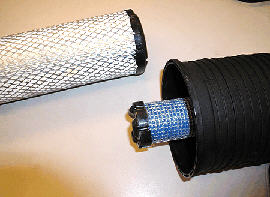 Dry-type air cleaner
Dry-type air cleaner 
- Dry-type air cleaner with safety element and electronic air service indicator
- Electronic air restriction indicator alerts operator when air filter servicing is required
- Dual-element design for added engine protection
- Easy to service
- Standard side exhaust
- Upward exhaust standard on turbo-charged Snow Cabs
- Optional vertical exhaust kit
Yanmar is a trademark of Yanmar Company Limited.
Maximise productivity with an eHydro™ transmission
The tractor comes with a three-range electronic hydrostatic (eHydro) transmission.
- Fluid under pressure transmits engine power to the drive wheels using a pump and motor
- Functions both as a clutch and transmission
- Provides high torque for startup
- Reduces powertrain shock loads
Danfoss® supplies both the pump and motor. This ensures that the components are matched to each other, providing maximum efficiency.
The electronic hydrostatic transmission is ideally suited for jobs where productivity is a must, such as loader or mower applications.
Twin Touch™ foot controls allow the operator to select both directions of travel and speed with a touch of the toe.
Key features of the eHydro transmission:
- Infinitely variable ground speeds, in each range, allow the operator to match the speed of the tractor to the job.
- No clutching means fast and easy direction changes.
- Twin Touch foot pedals provide quick and easy forward/reverse operation.
- Cruise control is standard equipment:
- Cruise control switch is located on the right-hand console for easy access.
- Cruise control is electronically engaged and disengaged, which allows for precise setting of speed.
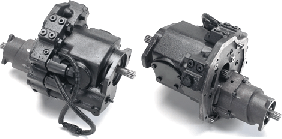 Danfoss eHydro transmission
Danfoss eHydro transmission Danfoss eHydro transmission is used for reliable operation. Durability features include:
Large forged trunnion shaft with larger support bearings that reduce vibration and noise
Center section made from ductile iron (much stronger than grey iron used in many competitive transmissions)
Transmission oil cooler cools transmission oil for longer transmission life
Safety features of the eHydro transmission include:
The tractor starts with one or both foot pedals depressed, but it does not move until both pedals first return to neutral.
Operator presence system means the tractor comes to a stop if the operator leaves the seat but does not shut off unless the power take-off (PTO) is also running.
Key John Deere advantage
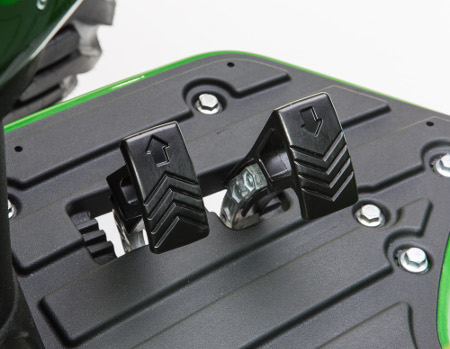 Twin Touch foot controls
Twin Touch foot controls John Deere's Twin Touch foot controls offer key advantages over competitive hydro model tractors.
- Some competitive hydrostatic tractors use a treadle pedal designed (toe-heel) foot control for operation of the hydro.
- Requires the operator to use both toe and heel to change direction, resulting in increased operator fatigue
Integrated eHydro features
The eHydro convenience controls have been integrated into a single module. Combining features such as SpeedMatch™ LoadMatch™, MotionMatch, eThrottle, and automotive-style cruise control pulls the maximum efficiency out of the eHydro transmission tractors. All these features are standard on the 4M Heavy Duty and 4R models and deliver an easier and more comfortable experience.
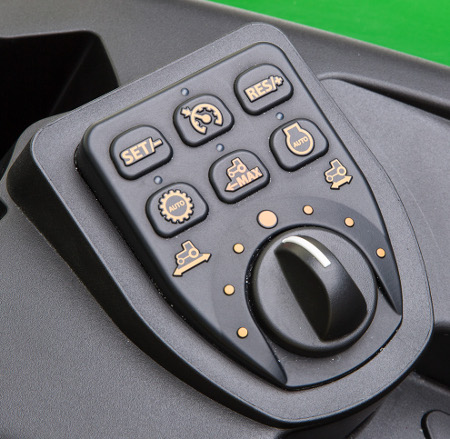 eHydro convenience control module
eHydro convenience control module
| Press button to active/deactivate eThrottle. When eThrottle is activated, depression of the travel pedal increases engine rpm and tractor speed. |
| Press button to active/deactivate LoadMatch. When LoadMatch is activated, engine will not stall during heavy load applications. |
| Press button to activate/deactivate SpeedMatch. When SpeedMatch is activated, operator is able to set the desired maximum travel speed. |
| Press button to activate/deactivate cruise control. When cruise control is activated, operator is able to set cruise speed. |
| Press button to set cruise speed, or to decrease cruise/set max speed. |
| Press button to resume set cruise speed, or to increase cruise/set max speed. |
| MotionMatch - longer accelerate and decelerate distances. |
| MotionMatch - shorter accelerate and decelerate distances. |
eThrottle
 eThrottle indicator
eThrottle indicator Press a button to activate/deactivate eThrottle. When eThrottle is activated, depression of the travel pedal increases engine rpm and tractor speed simultaneously. This provides the operator with comfort and convenience as well as fuel economy.
Automotive-style cruise control
 Cruise control indicator
Cruise control indicator An automotive-style cruise control is standard equipment on the 4M Heavy-Duty and 4R Series Tractors. Cruise control is electronically engaged and disengaged and is located on the right-hand operator console.
- Maintains desired forward speed without pressure on the foot pedal
- When activated, the operator is able to set cruise speed:
- Use the SET/- button to set cruise speed, or to decrease cruise/maximum speed
- Use the RES/+ button to set cruise speed, or to increase cruise/maximum speed
- A speed sensor also allows the tractor to maintain preset speed driving up and down hills
- To disengage the cruise control, either:
- Apply pressure to the brakes
- Disengage cruise control button
- Briefly depress the reverse travel pedal
LoadMatch power management system
 LoadMatch indicator
LoadMatch indicator LoadMatch is a standard feature on the 4M Heavy-Duty and 4R Series Tractors.
If torque requirements increase significantly, the transmission reduces the tractor's drive speed to compensate for the increased load on the transmission, maximizing torque to drive wheels and minimizing stalls.
Controls automatically adjust LoadMatch compensation depending on the tractor’s application. PTO applications require less engine speed fluctuation, therefore adjusting the amount of droop depending on PTO speed. This adjustment increases efficiency and optimizes engine speed and torque output based on tractor application.
While typically left on, LoadMatch can be turned off with the right-hand console controls.
MotionMatch
MotionMatch, standard on the 4M Heavy-Duty and 4R Series Tractors, is located on the right-hand console. It offers seven settings for adjusting the rollout or decelerating when the pedal is released.
 MotionMatch indicator
MotionMatch indicator This icon indicates longer accelerate and decelerate distances.
 MotionMatch indicator
MotionMatch indicator This icon indicates shorter accelerate and decelerate distances.
SpeedMatch
 SpeedMatch indicator
SpeedMatch indicator SpeedMatch, standard on the 4M Heavy-Duty and 4R Series Tractors, further enhances the eHydro cruise control functions by allowing the operator to preset maximum speed. Once this feature is engaged, the operator must stroke the travel pedal fully to meet the operator’s preset speed and press the Set button to lock the speed. From there, the operator can use the automotive-style cruise controls to adjust speed. This function will improve accuracy and safety, particularly at lower travel speed applications.
Rotary tilling or spraying applications are examples of where SpeedMatch can be applied. SpeedMatch will work in both the forward and reverse set speeds.
NOTE: Automotive-style cruise control and SpeedMatch can be used in conjunction with LoadMatch to maximise productivity.
Danfoss is a trademark of Danfoss A/S Corporation.
Standard premium ComfortGard™ cab provides superior comfort and performance
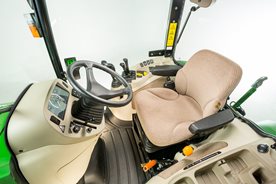 ComfortGard cab
ComfortGard cab 
John Deere ComfortGard cab tractors are the most comfortable, quiet, and easy-to-use cab tractors available. This premium solution was developed using extensive customer research and validation, tools, and some of the most advanced design techniques available.
The following John Deere ComfortGard cab tractor models are available:
- 4066R eHydro
Cab tractors are designed for those who demand superior performance:
- Large-property owners
- Commercial operators
- Governmental agencies
- Golf courses
- Growers
Whether using a loader to move dirt or remove snow or doing a variety of other tasks like mowing, front implement work (such as snow removal), tilling, rotary cutting, or light hay work, the cab tractors have the versatility and muscle to get the job done, all while protecting the operator from the elements.
Design
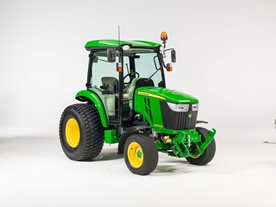 State-of-the-art design
State-of-the-art design 
- Designed and built by John Deere
- Certified to the highest safety standards in the industry
- Fingertip controls and an automotive-like fit and finish
Operators are sure to appreciate what this cab has to offer – beginning with an isolated cab. These cabs are designed with robust mounting points integrated into the rollover protective structure (ROPS) with a unique offset mounting design that provides an ultra-quiet ride.
A 4-post ROPS design, carefully laid-out interior, and fuel tank located under the left rear side of the operator's platform provide a full 360 degrees of visibility:
- Operators will enjoy a commanding view no matter what task is being performed.
- The raised header bar design allows operators – whether short or tall – to see the loader bucket or pallet forks through virtually the full range of operation.
- Operator fatigue caused by awkward bending is reduced, leading to an increase in overall productivity.
- Ample headroom and curved glass on all four sides provide a spacious interior and give operators the feel of a large-tractor cab.
Operators are well-protected from the elements with a high-performance climate-control system providing heating and air conditioning.
- The climate-control system makes any task more enjoyable whether on a frigid winter day or a hot summer day.
- The cab is tightly sealed to help reduce exposure to dust and allergens.
- A standard high-efficiency clean-air filter keeps even the smallest dust and allergen particles out.
- Improved HVAC system with larger capacity condenser cools the cab faster in a hot climate.
Cab comfort features
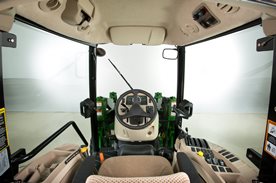 Superior operator comfort
Superior operator comfort 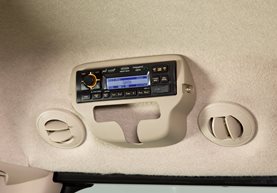 Comfort Cab ‘Radio Ready’ from factory
Comfort Cab ‘Radio Ready’ from factory Several features are integrated into the design of the cab that deliver superior operator comfort and visibility:
- Ultra-quiet interior
- Superior cooling performance
- 4-post ROPS with curved glass for 360-degree visibility and spacious interior
- High-performance climate-control system for maximum operator comfort
- Raised header bar for maximum loader visibility
- Right-hand control center with the most frequently used controls at the operator's fingertips
- Left-hand automotive-style park brake
- Dash-mounted four-wheel drive (4WD) engagement, so there is no awkward bending
- Standard tilt steering
- Improved shift range linkage for ease in operation
- Flat unobstructed foot platform
- Standard air suspension seat, providing ultimate comfort and reduced operator fatigue
- Inside rearview mirror for rear visibility
- Dual exterior rearview mirrors for added rear visibility
- Ergonomically placed integrated loader joystick control for maximum comfort during operation
- Interior dome light with on, door, and off positions for illumination in low-light conditions
- Radio ready – pre wired with receiver and speakers.
- Standard sun visor to block unwanted sunlight
- Creature comforts like:
- Dual cup holders
- 12-V power supply
- Cell phone storage
- Hitch pin storage
- Miscellaneous storage
- Operator's manual holder
- Integrated handle for convenient support for entering and exiting
- Left-side step for convenient entrance and exit
Cab operating features
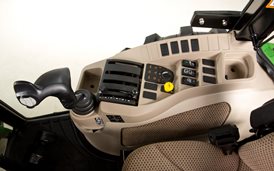 Right-hand control panel
Right-hand control panel 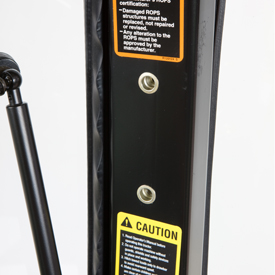 Side-post mounting bosses
Side-post mounting bosses Optional lighting
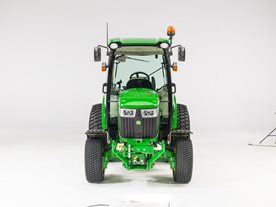
Optional lighting includes:
- Dual roof-mounted adjustable rear work lights Rotating beacon light (field-installed kit only for cab tractors)
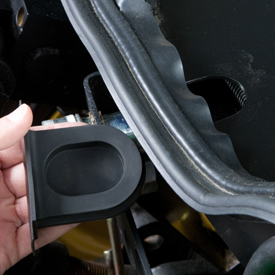 Installing rear window removable plug
Installing rear window removable plug 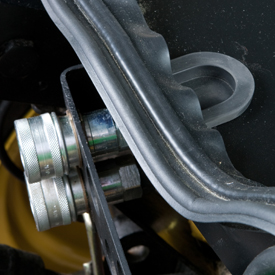 Rear window removable plug installed
Rear window removable plug installed - Tech Ready with CAN connector (HDSCS 7-pin) for implement connectivity and telematics
- Pre-wired for optional accessories like radio, horn, rear work lights, electric hydraulic diverter, third electrohydraulic selective control valve (SCV), dual rear SCV, rear wiper/washer, beacon light, and cigarette lighter
- Integrated warning lights/turn signals and taillights, protected from trees and branches
- Integrated roof-mounted antenna, protected from potential damage from trees and branches
- Dual roof-mounted forward work lights for optimum forward visibility at night
- Standard two-speed front windshield wiper to keep the front glass clear
- Standard rear wiper on the deluxe cab keeps the rear glass clear (standard on the 4066R Deluxe Cab model.)
- Optional front fenders to protect the front cab glass from mud and debris
- Optional rear fender extensions to help protect the doors from mud and debris
- High-impact polymer fenders, dent resistant and painted to an automotive-like finish
- Rear glass that swings out 70 degrees for ventilation
- Easy access to route and mount the controller or monitor through the rear window removable plug and mounting bosses on the side post
- Large, 49-L (13-gal.) fuel tank for longer operation without refueling
- Left-rear fender fuel fill with large opening for easy refueling
- Fuel tank located under the left side of the operator's station for maximum rear visibility
Cab safety features
- ROPS – certified to the highest industry standards for maximum operator protection
- Operator presence system
- Engine shuts down if the operator leaves the seat when the any power take-off (PTO) is engaged
- Tractor must have the park brake fully set for stationary PTO work
- Right-side emergency exit
- Tempered safety glass in case of breakage
- Roof-mounted warning lights/turn signals for road transport – two front and two rear
- Two fender-mounted taillights
Deluxe air-suspension seat
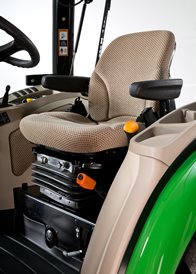 Air-suspension seat
Air-suspension seat 
An air-ride seat is standard on the 4R Cab Tractor. This seat is designed to provide an air cushion for vertical-seat travel which provides maximum operator comfort in any terrain.
Seat features:
- Push the button at the base of the seat to pump up the seat. Pull the button to deflate the seat.
- The seat slides fore-aft with a lever on the right-hand side of the seat.
- The seat back reclines with the lever in the lower-left corner of the seat cushion.
NOTE: The deluxe two-piece seat top may be ordered through Parts.
Key benefits include:
- Maximum-ride comfort and quality, thus minimizing operator fatigue
- Dampens lower frequency vibration better than mechanical suspensions
- Increased operator weight capacity of 150 kg
- Closeout boot for enhanced appearance
Lighting equipment
The base lighting package for cab tractors includes:
- Two wide-angle light-emitting diode (LED) headlights
- Light equipment fulfills EEC homologation requirements. (NOTE: EEC road homologation requirements not applicable for Australia/New Zealand).
- Two roof-mounted, adjustable LED forward work lights, which illuminate the work area in low-light conditions
- Two taillights integrated into the fenders
- Three-position (on/off/auto) interior dome light
- LED beacon light
Built-in safety features for operator peace of mind
Safety is designed into all 4M and 4R Series Tractors.
- Operator presence system ensures the operator is in the seat to run the tractor
- If the operator leaves the seat when front or rear power take-off (PTO) is engaged, the engine shuts down.
- For stationary PTO work, the tractor must be in neutral and the park brake fully set.
- The rollover protective structure (ROPS) is designed for operation safety
- Reflective ROPS strips for better tractor visibility
- Key switch interlock prevents bypass starting
- Visual PTO warning light alerts operator when rear PTO is running
- Placing the transmission in neutral and setting the park brake allows operator to run rear PTO safely when off the tractor seat
- Turn signal and flashing warning lights operate according to ASAE S279.10 standard
- Taillights for road transport
- Slow moving vehicle (SMV) sign for road transport
Hitch assist and auxiliary 3-point hitch control for easy implement hookup
Hitch assist (ground positioning)
The hitch assist feature allows the operator to creep the tractor backward or forward while standing behind the tractor. Engaging and operation includes the following steps:
- Ensure hitch assist switch is in off position (A below)
- Engage the park brake
- Select A range
- Set to low throttle
- Ensure power take-off (PTO) is off
- Operator must be in the tractor’s seat
- Activate the hitch assist switch
- If successful, flashers will trigger
- If not, the missing interlock will be displayed on the LCD screen
- Once flashers are triggered, if the operator leaves the seat, the display will beep indicating that the hitch assist is in remote mode
- Operator moves to back of the tractor, start motion of the tractor using the enable button (B below) and corresponding direction button (C below)
- Push and hold both buttons continuously as long as motion is desired
- Audible alarm will sound indicating motion of the tractor
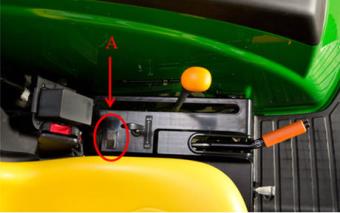 Hitch assist switch
Hitch assist switch 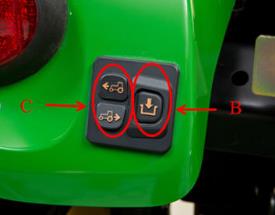 Enable and directional buttons
Enable and directional buttons Auxiliary 3-point hitch control
The auxiliary 3-point hitch control on the left-hand fender allows the operator to raise or lower the hitch while standing on the ground behind the tractor.
Pairing the auxiliary 3-point hitch control with hitch assist, changing implements has never been easier. Both features are in base equipment for 4R Series eHydro™ transmission models.
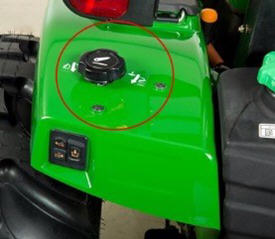 Auxiliary 3-point hitch control (open station tractor)
Auxiliary 3-point hitch control (open station tractor) 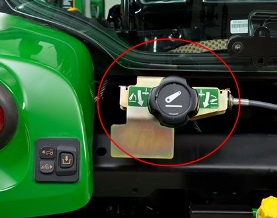 Auxiliary 3-point hitch control
Auxiliary 3-point hitch control Electrohydraulic (EH) hitch control operation
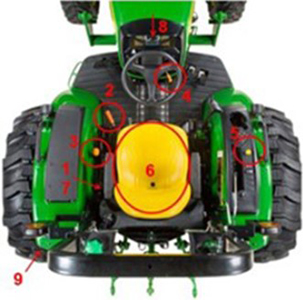 Electrohydraulic (EH) hitch control operation
Electrohydraulic (EH) hitch control operation The EH Hitch control provides more operator comfort and precision when moving the hitch up and down. It enables the operator to set both an upper and lower limit. Hitch depth can be set from 0 -9. Zero being the highest and can be locked for transport. 9 is the lowest setting. Electronic controls also offer a quick raise and lower function.
The adjustable depth stop provides consistency when lowering the hitch. Each time the position control lever is pushed forward, it stops where the depth stop has been positioned. This feature is a value to anyone who desires a consistent, level ground, like when preparing a seedbed.
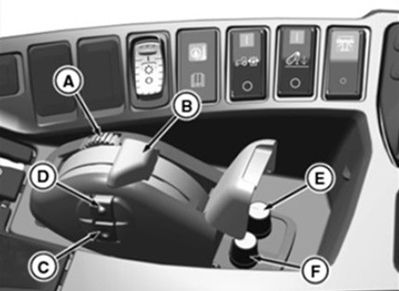
A – Position Control Lever Stop - Push down and rotate wheel (A) until stop sets to desired working depth. Implement returns to set depth when position control lever is pushed forward to contact stop. A few minutes of implement operation helps determine the best depth. To lower hitch below the preset depth stop, lift position control lever (B) and push forward past stop.
B – Position Control Lever - Position control lever controls raise or lower movement of rear hitch-mounted implement and ground depth penetration. Pull lever rearward to raise and push lever forward to lower.
- Transport: Pull lever full rearward past “0” to transport implement. Ensure that lever is in transport lock position (lever flipped over latch at the padlock symbol).
C – Quick Lower Button - Depress the quick lower button (C) to return the hitch to the set working depth. Hold down quick lower button (C) while machine is moving for 1 second to activate quick raise/lower feature.
D – Quick Raise Button - Depress quick raise button (D) to raise the hitch to the upper limit setting
E – Upper Limit Adjustment Control Knob - Turn knob to set the maximum raised position of the hitch. This allows the operator a means to adjust the maximum height to which the hitch moves when a raise command is executed.
F – Rate of Drop Adjustment Control Knob - Turn knob to set the rate at which the hitch lowers. This allows the operator a means to adjust the rate at which the hitch moves when a lower command is executed.
EH Hitch Raise & Lower Buttons
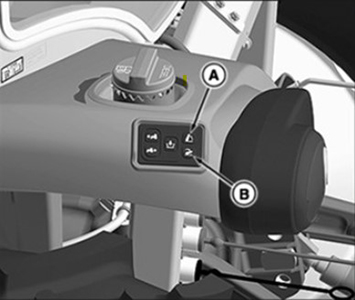 Implement is raised when top switch (A) is held.
Implement is raised when top switch (A) is held.Implement is lowered when bottom switch (B) is held.
Save fuel, reduce noise, and increase engine life with the economy power take-off (PTO)
The optional field-installed 540/540 economy power take-off (PTO) allows operators to select the engine rpm needed for their PTO application. The economy position provides 540 rpm to the PTO at approximately 70 percent of the engine's normal rated speed. The engine runs at a rated speed of approximately 1750 rpm in the 540 economy position. The 540 economy is ideal for any PTO application, from running a mower to a baler or a cutter, where full horsepower is not needed. Operating at lower engine rpm decreases fuel costs during tasks. The overall operating experience improves because there is less noise and vibration for the operator.
A conveniently located lever (behind the seat of the tractor) allows the operator to simply change between 540 and 540E when conditions merit the opportunity to save fuel without affecting performance. For heavy-duty operations that require maximum PTO power, the PTO shift lever is placed in the 540 position, the PTO engaged, and the engine is run at rated speed of 2400 rpm. This selection gives 540 rpm to the PTO shaft and delivers the full-advertised horsepower at rated engine speed.
The 540/540 economy PTO offers all the features of the standard 540-rpm PTO, and the safety interlock is a foolproof measure provided to compensate for operator oversight. When the tractor is in economy, the engine is limited to a lower operating speed, preventing accidental over speeding of PTO implements and protecting against binding the PTO shaft. The safety interlock also prevents accidental shifting of the PTO selector lever at higher engine speeds than the economy PTO setting, which would lead to downtime to fix implements or drivetrains. Please note that economy PTO is only applicable to 4066R.
Excellent serviceability reduces operational costs and improves productivity
Regular service and maintenance are essential to the performance, productivity, and longevity of the tractor.
- Easy access to regular service points minimises service time.
- Easily removable cowl and side panels, improved hood design, and integrated maintenance position on the grille provide easy accessibility for routine maintenance.
- Tractors are equipped with extensive onboard self-diagnostic capabilities and are fully compatible with exclusive John Deere Service ADVISOR™ system.
- Daily service requirements are minimal and simple to accomplish. Most service interval requirements can be performed with a basic understanding of procedures and common tools.
- Improved cost of ownership
- Hydraulic oil service interval changed from 400 to 1200 hours (or 3 years) when using Hy-Gard™ products
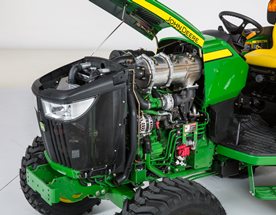 Removable side panels
Removable side panels 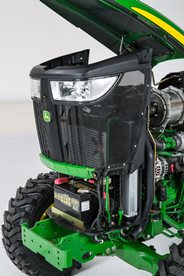 Integrated grille maintenance position
Integrated grille maintenance position 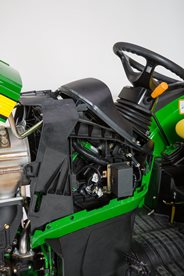 Removable cowl
Removable cowl All items in the daily service schedule can be performed without the use of tools:
- Engine oil, hydraulic oil, coolant level, and the water separator can be conveniently accessed
- The engine can be easily accessed by simply raising the hood for more periodic maintenance checks
- A single-point latch mechanism and self-contained leash ensure easy hood opening and closure
NOTE: Always refer to the operator’s manual for complete maintenance and service recommendations.























